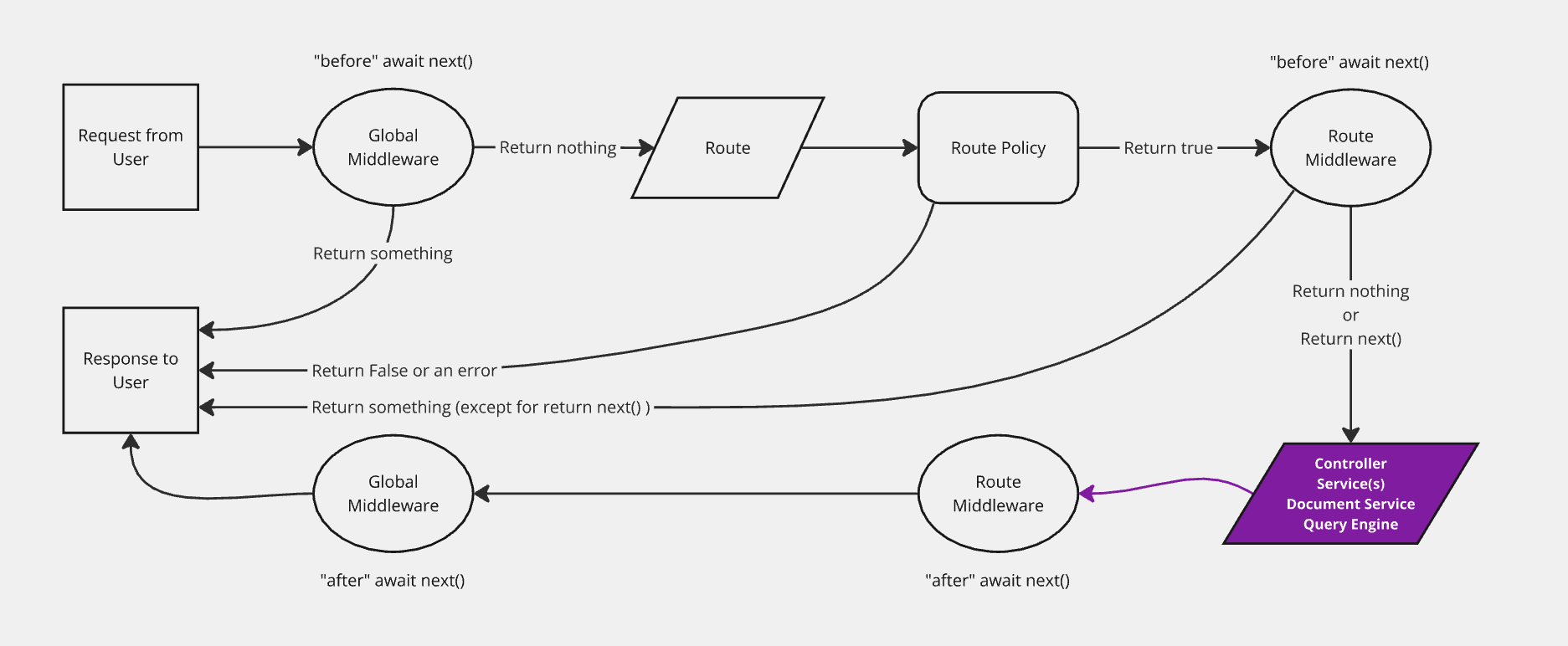文档服务 API:中间件
¥Document Service API: Middlewares
文档服务 API 提供了通过中间件扩展其行为的能力。
¥The Document Service API offers the ability to extend its behavior thanks to middlewares.
文档服务中间件允许你在方法运行之前和/或之后执行操作。
¥Document Service middlewares allow you to perform actions before and/or after a method runs.

注册中间件
¥Registering a middleware
语法:strapi.documents.use(middleware)
¥Syntax: strapi.documents.use(middleware)
参数
¥Parameters
中间件是一种接收上下文和下一个函数的函数。
¥A middleware is a function that receives a context and a next function.
语法:(context, next) => ReturnType<typeof next>
¥Syntax: (context, next) => ReturnType<typeof next>
| 范围 | 描述 | 类型 |
|---|---|---|
context | 中间件上下文 | Context |
next | 调用堆栈中的下一个中间件 | function |
context
| 范围 | 描述 | 类型 |
|---|---|---|
action | 正在运行的方法(查看可用方法) | string |
params | 方法参数 (查看可用方法) | Object |
uid | 内容类型唯一标识符 | string |
contentType | 内容类型 | ContentType |
Examples:
以下示例显示了 context 可能包含的内容(具体取决于调用的方法):
¥The following examples show what context might include depending on the method called:
- findOne
- findMany
- create
- update
- delete
{
uid: "api::restaurant.restaurant",
contentType: {
kind: "collectionType",
collectionName: "restaurants",
info: {
singularName: "restaurant",
pluralName: "restaurants",
displayName: "restaurant"
},
options: {
draftAndPublish: true
},
pluginOptions: {},
attributes: {
name: { /*...*/ },
description: { /*...*/ },
createdAt: { /*...*/ },
updatedAt: { /*...*/ },
publishedAt: { /*...*/ },
createdBy: { /*...*/ },
updatedBy: { /*...*/ },
locale: { /*...*/ },
},
apiName: "restaurant",
globalId: "Restaurants",
uid: "api::restaurant.restaurant",
modelType: "contentType",
modelName: "restaurant",
actions: { /*...*/ },
lifecycles: { /*...*/ },
},
action: "findOne",
params: {
documentId: 'hp7hjvrbt8rcgkmabntu0aoq',
locale: undefined,
status: "publish"
populate: { /*...*/ },
}
}
{
uid: "api::restaurant.restaurant",
contentType: {
kind: "collectionType",
collectionName: "restaurants",
info: {
singularName: "restaurant",
pluralName: "restaurants",
displayName: "restaurant"
},
options: {
draftAndPublish: true
},
pluginOptions: {},
attributes: {
name: { /*...*/ },
description: { /*...*/ },
createdAt: { /*...*/ },
updatedAt: { /*...*/ },
publishedAt: { /*...*/ },
createdBy: { /*...*/ },
updatedBy: { /*...*/ },
locale: { /*...*/ },
},
apiName: "restaurant",
globalId: "Restaurants",
uid: "api::restaurant.restaurant",
modelType: "contentType",
modelName: "restaurant",
actions: { /*...*/ },
lifecycles: { /*...*/ },
},
action: "findMany",
params: {
filters: { /*...*/ },
status: "draft",
locale: null,
fields: ['name', 'description'],
}
}
{
uid: "api::restaurant.restaurant",
contentType: {
kind: "collectionType",
collectionName: "restaurants",
info: {
singularName: "restaurant",
pluralName: "restaurants",
displayName: "restaurant"
},
options: {
draftAndPublish: true
},
pluginOptions: {},
attributes: {
name: { /*...*/ },
description: { /*...*/ },
createdAt: { /*...*/ },
updatedAt: { /*...*/ },
publishedAt: { /*...*/ },
createdBy: { /*...*/ },
updatedBy: { /*...*/ },
locale: { /*...*/ },
},
apiName: "restaurant",
globalId: "Restaurants",
uid: "api::restaurant.restaurant",
modelType: "contentType",
modelName: "restaurant",
actions: { /*...*/ },
lifecycles: { /*...*/ },
},
action: "create",
params: {
data: { /*...*/ },
status: "draft",
populate: { /*...*/ },
}
}
{
uid: "api::restaurant.restaurant",
contentType: {
kind: "collectionType",
collectionName: "restaurants",
info: {
singularName: "restaurant",
pluralName: "restaurants",
displayName: "restaurant"
},
options: {
draftAndPublish: true
},
pluginOptions: {},
attributes: {
name: { /*...*/ },
description: { /*...*/ },
createdAt: { /*...*/ },
updatedAt: { /*...*/ },
publishedAt: { /*...*/ },
createdBy: { /*...*/ },
updatedBy: { /*...*/ },
locale: { /*...*/ },
},
apiName: "restaurant",
globalId: "Restaurants",
uid: "api::restaurant.restaurant",
modelType: "contentType",
modelName: "restaurant",
actions: { /*...*/ },
lifecycles: { /*...*/ },
},
action: "update",
params: {
data: { /*...*/ },
documentId: 'hp7hjvrbt8rcgkmabntu0aoq',
locale: undefined,
status: "draft"
populate: { /*...*/ },
}
}
{
uid: "api::restaurant.restaurant",
contentType: {
kind: "collectionType",
collectionName: "restaurants",
info: {
singularName: "restaurant",
pluralName: "restaurants",
displayName: "restaurant"
},
options: {
draftAndPublish: true
},
pluginOptions: {},
attributes: {
name: { /*...*/ },
description: { /*...*/ },
createdAt: { /*...*/ },
updatedAt: { /*...*/ },
publishedAt: { /*...*/ },
createdBy: { /*...*/ },
updatedBy: { /*...*/ },
locale: { /*...*/ },
},
apiName: "restaurant",
globalId: "Restaurants",
uid: "api::restaurant.restaurant",
modelType: "contentType",
modelName: "restaurant",
actions: { /*...*/ },
lifecycles: { /*...*/ },
},
action: "delete",
params: {
data: { /*...*/ },
documentId: 'hp7hjvrbt8rcgkmabntu0aoq',
locale: "*",
populate: { /*...*/ },
}
}
next
next 是一个没有参数的函数,它调用堆栈中的下一个中间件并返回其响应。
¥next is a function without parameters that calls the next middleware in the stack and return its response.
示例
¥Example
strapi.documents.use((context, next) => {
return next();
});
在哪里注册
¥Where to register
一般来说,你应该在 Strapi 注册阶段注册你的中间件。
¥Generaly speaking you should register your middlewares during the Strapi registration phase.
用户
¥Users
中间件必须在通用 register() 生命周期方法中注册:
¥The middleware must be registered in the general register() lifecycle method:
module.exports = {
register({ strapi }) {
strapi.documents.use((context, next) => {
// your logic
return next();
});
},
// bootstrap({ strapi }) {},
// destroy({ strapi }) {},
};
插件开发者
¥Plugin developers
中间件必须在插件的 register() 生命周期方法中注册:
¥The middleware must be registered in the plugin's register() lifecycle method:
module.exports = {
register({ strapi }) {
strapi.documents.use((context, next) => {
// your logic
return next();
});
},
// bootstrap({ strapi }) {},
// destroy({ strapi }) {},
};
实现中间件
¥Implementing a middleware
实现中间件时,始终返回来自 next() 的响应。如果不这样做,Strapi 应用就会崩溃。
¥When implementing a middleware, always return the response from next().
Failing to do this will break the Strapi application.
示例
¥Examples
const applyTo = ['api::article.article'];
strapi.documents.use(async (context, next) => {
// Only run for certain content types
if (!applyTo.includes(context.uid)) {
return next();
}
// Only run for certain actions
if (['create', 'update'].includes(context.action)) {
context.params.data.fullName = `${context.params.data.firstName} ${context.params.data.lastName}`;
}
const result = await next();
// Modify the result as necessary before returning it
result.retrievedAt = Date.now();
return result;
});
-
文档服务 API 根据调用的方法触发各种数据库生命周期钩子。有关完整参考,请参阅 文档服务 API:生命周期钩子。
¥The Document Service API triggers various database lifecycle hooks based on which method is called. For a complete reference, see Document Service API: Lifecycle hooks.
-
你可能会在 Strapi 博客文章 中的文档服务中间件与生命周期钩子主题上找到更多信息。
¥You might find additional information on the topic of Document Service middlewares vs. lifecycle hooks in a Strapi blog article.